|
A l l i e d F o r c e s
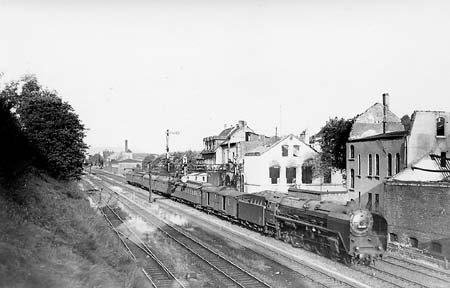
The beautiful Hudson 05 003 with the British military express M8, Wuppertal-Unterbarmen 1947 (Carl Bellingrodt/ Eisenbahn-Kurier)
|
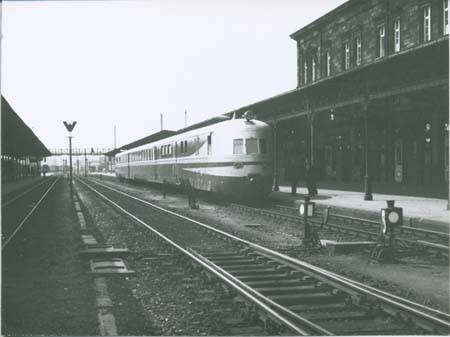
Diesel special 2-22-222 of the U.S. High Commissioner at Hof, 1950 (Buettner, MSC Hof)
|
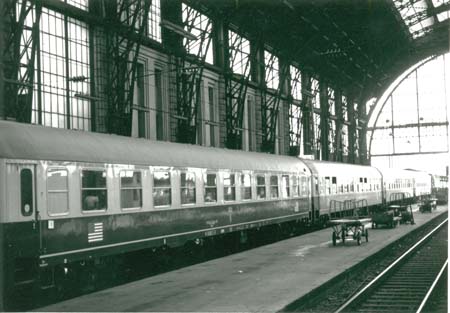
U.S. military train Frankfurt/M - Berlin, Frankfurt around 1980 (WS)
|
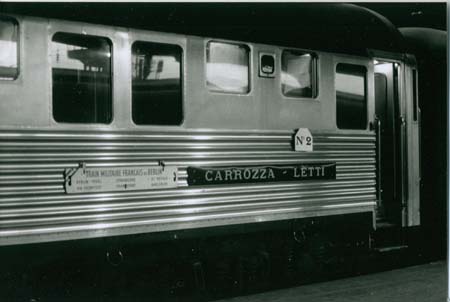
CIWL sleeper type P, French military train Strasbourg - Berlin, 1970 (WS)
|
After World War II the victorious Allied Forces got by a deal with the Soviets the enclave West Berlin with the right to use the railway via Helmstedt. November 20, 1945 was the official date for the start of the American, British and French military expresses to West Berlin. And there were also the commanders’ specials. The silver/olive 2-22-222 (later VT06 108) served the U.S. Commander in Berlin, General Clay. It was one of the three fast “Koeln” railcar sets, rebuilt as comfortable headquarters for German generals, captured in 1945 during their escape run from Berlin to Berchtesgaden. Number 4-44-444 (VT06 109), olive with a blue/yellow ribbon and the Constabler label, served General Harmon and 6-66-666 (VT 06 107) was for General Huebner (all informations by Peter Jauch). 4-44-444 was around 1947 a frequent guest at Tegernsee in the Bavarian Alps, where also a grey four-car set 137 851 appeared, the “Dreamliner” for US holiday trips. The timetable for 1947/48 listed an US express Munich - Heidelberg - Helmstedt - Berlin, alternatively a Dt-US 24/25 - that was the “Dreamliner”! General Clay’s 2-22-222 sometimes had been coupled with a motorcar transporter (possibly a rebuilt German “Landserschlafwagen”, a sort of a soldiers’ couchette car) and it could have been replaced by a steam-hauled train, consisting of a van, a sleeper, a diner and a government’s saloon. The much simplier railcars type VT33 served the British commander and VT36 the French General Koenig. From April 1948 the Soviets troubled the traffic, but 2-22-222 together with VT04 107 could escape from Berlin. During the Berlin blockade from June 19, 1948 until May 12, 1949, the Western military trains ran on secret, irregular schedules (according to Gottfried Krueger-Wittmack). After the blockade, the expresses continued regular traffic: the American ones from Frankfurt and from Bremerhaven to Berlin Lichterfelde (West), the British “Berliner” from Bad Oeynhausen, Hanover or Brunswick to Berlin Charlottenburg and the “Franzosenzug”, later from Strasbourg, to Berlin Tegel, temporarily with CIWL sleepers of the blue S, then the silver P type.
And for the U.S. Ambassador once again the former "Dreamliner" appeared, rebuilt as a three-car set, numbered VT06 106 and painted dark-blue.
For civilians, the Nord-Express, now also with ordinary coaches, including the French "Art Deco" type, started on May 6, 1946 from Paris to Berlin Charlottenburg. On October 7 followed its branch FD111/112 Amsterdam - Berlin, which became the notorious "Interzonenzug". The main destination of the Nord-Express however was Scandinavia and from 1957 it had no longer any cars to Berlin.
After German reunification, the Allied Forces' expresses to Berlin disappeared one-by-one - in December 1990 the last "Ami-Zug" and the British "Berliner" and on Spetember 28, 1994 the nice blue/light-grey "Franzosenzug". Two of the French FFA's cars of German type finished their career on the Tegernsee-Bahn in the Bavarian Alps.
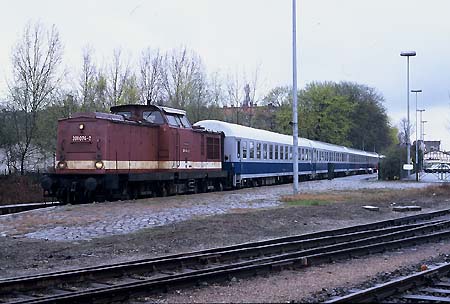 "Franzosenzug" Berlin - Strasbourg, ex-DR diesel 210 074, Berlin Tegel, April 1992 (WS)
"Franzosenzug" Berlin - Strasbourg, ex-DR diesel 210 074, Berlin Tegel, April 1992 (WS)
|
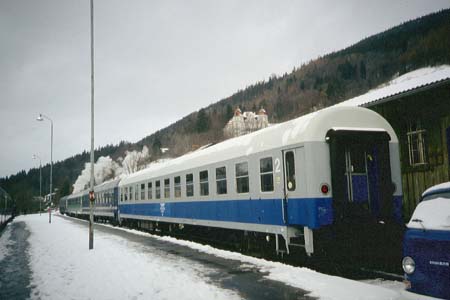
Car of French TMFB military trains, acquired by Tegernsee-Bahn, Tegernsee 1993 (WS)
|
|










